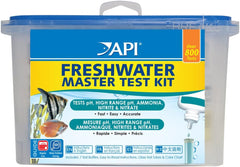Important to the success of aquaponics is the delicate balance of various factors, among which pH plays a crucial role. pH, which is the measure of acidity or alkalinity of a solution, can influence the health and productivity of plants and aquatic life within the system. When the pH level is outside of the ideal range, it can cause low plant growth and unhealthy fish, or it could lead to the death of one or more of these living components of the system.
This article will answer the question of why pH is important in aquaponics systems. We will also explore its fundamental principles, its impact on system dynamics, and the importance of maintaining optimal pH levels for thriving aquaponics ecosystems.
Why pH is Important Aquaponics Systems?
pH is a measure of the acidity or alkalinity of a solution which is determined by the concentration of hydrogen ions present. The pH scale ranges from 0 to 14, where a pH of 7 is considered neutral, below 7 is acidic, and above 7 is alkaline.
In aquaponics, factors such as water quality, temperature, dissolved oxygen levels, and pH must be monitored and managed to ensure the health and productivity of plants and fish. Among these factors, pH stands out as a critical parameter because it directly impacts nutrient availability, microbial activity, and overall system stability.The pH level directly affects the solubility and uptake of essential nutrients by plants, influencing their growth and development. Additionally, pH influences the toxicity of certain substances, such as ammonia, which can harm aquatic life at elevated pH levels.

The pH Scale and Its Relevance to Aquaponics
The pH scale serves as a universal measure for assessing the acidity or alkalinity of water in aquaponics systems. Ideally, aquaponic systems operate within a pH range of 6.8 to 7.2, which is slightly acidic to neutral. This range is optimal for most plants and fish species that reside in the system. However, sometimes a specific plant or fish may have different pH preferences, which requires pH level adjustments to maintain suitable conditions. Monitoring pH levels regularly and making necessary adjustments is important to prevent fluctuations that could disrupt the delicate balance of the system and compromise the health of the organisms within it.
Factors That Influence pH in Aquaponics Systems
Several factors can influence pH levels in aquaponic systems, which require careful management to maintain stability:
- Fish waste: The breakdown of fish waste releases ammonia into the water, which can affect pH levels, particularly if not adequately processed by beneficial bacteria. Overfeeding fish can lead to an excess of waste, which can cause pH levels to rise.
- Biological processes:The biological processes, such as the breakdown of fish waste and the conversion of ammonia into nitrates, can affect pH levels. When fish waste breaks down, it releases ammonia into the water, which can increase the pH level. However, the pH level can decrease as the ammonia is converted into nitrites and then nitrates by beneficial bacteria. So it is crucial to monitor the system's biological processes and adjust pH levels accordingly.
- Plant uptake: As plants absorb nutrients from the water, they can alter pH levels by depleting certain ions, such as nitrate or carbonate.
- Carbon dioxide levels: High levels of carbon dioxide can lead to the formation of carbonic acid, lowering pH levels in the water.
- Water Quality and Composition:The composition and water quality used in the aquaponic system can impact pH levels. The pH level of the water source may be naturally high or low, and its composition can also affect pH levels. Testing the water source and making any necessary adjustments can help maintain a stable pH level.
Consequences of Imbalanced pH in Aquaponics
1. Stunted Plant Growth and Poor Yields:
Imbalanced pH levels in aquaponics systems can result in stunted plant growth and diminished yields. When pH deviates from the optimal range, nutrient uptake by plants becomes compromised. The essential nutrients may become unavailable or inaccessible to plant roots which can hinder their growth and development. Additionally, fluctuating pH levels can disrupt the physiological processes within plants which can lead to nutrient imbalances, reduced photosynthesis, and overall poor plant health. As a consequence, plants may exhibit stunted growth, yellowing or discolored leaves, and diminished fruit or vegetable production, that will result in poor yields and reduced productivity within the aquaponics system.
2. Nutrient Deficiencies or Toxicities:
Imbalanced pH levels can lead to nutrient deficiencies or toxicities in aquaponics systems, which can negatively affect both plant and fish health. Certain nutrients are more readily available to plants within specific pH ranges, and deviations from these optimal conditions can affect nutrient solubility and availability.
3. Fish Stress and Risk of Disease Outbreaks:
In aquaponic systems, imbalanced pH levels can stress fish and increase the risk of disease outbreaks. Fish are sensitive to changes in water chemistry, including fluctuations in pH, which can disrupt their physiological functions and immune responses. Elevated or fluctuating pH levels can cause stress responses in fish, leading to decreased appetite, impaired growth, and increased susceptibility to diseases.
Tools for Measuring pH in Aquaponics
Monitoring pH levels is essential for maintaining the health and stability of aquaponic systems. Here are several tools available for accurately measuring pH in aquaponics:
A. pH meters
Digital pH meters provide precise readings of pH levels in the water. These meters typically feature probes that are immersed directly into the aquaponic water, allowing for real-time monitoring of pH.
Our recommended pH meters for aquaponics systems:
1. Hanna Waterproof Pocket pH Tester
Check on Gogreen
Check on Amazon
A compact and affordable pH meter designed for on-the-go testing in aquaponic setups. This accurate pH tester features 0.1 resolution with automatic two-point calibration and temperature compensation in a single, portable, pocket device.
2. Bluelab pH Pen
A portable and waterproof pH meter with a digital display, suitable for quick and accurate pH measurements in aquaponics systems. It features a replaceable probe and automatic temperature compensation for reliable results.
B. pH Test Kits
Test kits containing pH indicator solutions or test strips are cost-effective alternatives for monitoring pH. These kits provide colorimetric readings based on the color change of the indicator solution or test strip when immersed in the water sample.
Our recommended pH test kits for aquaponics systems:
1.API Freshwater Master Test Kit
Check on Gogreen
Check on Amazon
This comprehensive test kit includes tests for pH, ammonia, nitrite, and nitrate levels, providing a complete solution for monitoring water quality in aquaponics systems. It offers easy-to-read color charts and accurate results for precise pH measurements.
2. LaMotte 5858-01 pH Test Kit
A professional-grade pH test kit is suitable for aquaponics enthusiasts and commercial operators alike. It features high-quality reagents and precision colorimetric analysis for accurate pH measurements in aquaponics systems.
C. Continuous Monitoring Systems
Automated pH monitoring systems offer continuous monitoring of pH levels in aquaponics systems. These systems often integrate with controllers or alarms to alert users of any fluctuations or deviations from the desired pH range.
Our recommended monitoring system for aquaponics systems:
1. Bluelab Guardian Monitor Connect
This advanced monitoring system offers continuous monitoring of pH, conductivity, and temperature in aquaponic systems. It features wireless connectivity, allowing users to remotely access and view real-time data via a smartphone or computer. The Guardian Monitor Connect provides accurate and reliable measurements, making it an excellent choice for aquaponic enthusiasts and commercial operators.
2. HYDROS Pinpoint pH Pro
The HYDROS Pinpoint pH Probe is a Probe port accessory. Set target pH ranges for your system on the app and receive immediate mobile alerts when the pH rises or falls out of the safe range.
How to Adjust pH in Aquaponics
When pH levels deviate from the optimal range, various strategies can be employed to adjust and stabilize pH in aquaponic systems:
A. How to Raise pH in Aquaponics?
How to raise the pH level in your system by:
- Combining equal amounts of calcium carbonate and potassium carbonate adds the mixture to the water. Carbonates are preferred because they will add strength to the carbonate buffer.
- Another option is to do a water change, as this will help replace the acidic water with more neutral water. Changing the water will prevent immediate damage to your fish and bacteria.
- Using a grow media that is slightly alkaline, such as crushed limestone, can also help in raising the pH level in your aquaponics system
B. How to Lower pH in Aquaponics
Several methods can be used in lowering the pH level in an aquaponics system; these are:
1. In newly built aquaponics systems undergoing the cycling stage, allowing the proper time for the bacteria to establish a bacterial colony is the right way to lower the pH level. This can be done by gradually increasing ammonia levels until nitrite is produced and nitrates are present in the system. Once the system is fully cycled, the water pH level will lower naturally.
2. Another method to lower the pH level is using certain acids, such as phosphoric acid, which is safe and effective.
3. A reverse osmosis (RO) filter can also be used to lower your aquaponics system's pH level. RO filters can remove the carbonates from the water.

Best Practices for Managing pH in Aquaponics Systems
Follow these practices to ensure effective pH management in your aquaponic system.
- Regular monitoring: Routinely monitor pH levels using appropriate testing tools to promptly identify and address any deviations from the optimal range.
- Record keeping: Keep detailed records of pH measurements and any pH adjustment actions taken to track trends and evaluate the effectiveness of pH management strategies.
- Gradual adjustments: Avoid rapid pH changes, as sudden fluctuations can stress plants and fish. Instead, make gradual adjustments over time to allow the system to acclimate.
- Balance other factors: Consider the interplay between pH and other water parameters, such as temperature and dissolved oxygen levels, when managing pH to maintain overall system stability.
Conclusion
The importance of pH in aquaponics systems cannot be overstated as it influence nutrient availability, plant growth, microbial activity, and overall system health. Maintaining optimal pH balance within the recommended range is essential for maximizing productivity, sustainability, and the well-being of both plants and fish in aquaponic systems. By diligently monitoring, managing proactively, and implementing effective strategies, you can ensure stable pH levels and create thriving ecosystems capable of producing bountiful harvests.












Cindy
July 16, 2023
Hi my system pH is recently betwewn 6.0-6.4( according to the test kit reading)
How to increase the volume of calcium carbonate and potassium carbonate into the water system?
The ratio between these two components?